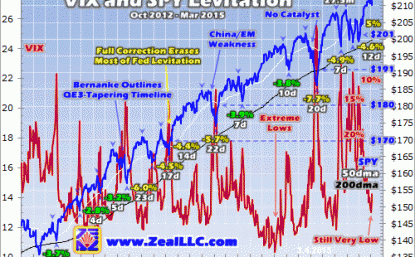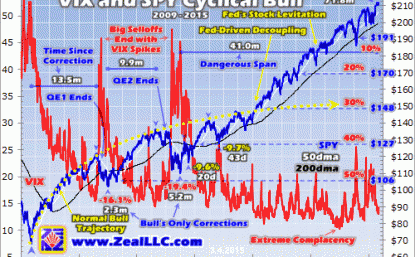
The latest record highs in the US stock markets have unleashed astounding complacency. Traders are utterly convinced that the past couple years’ massive Fed-fueled rally will continue indefinitely. But with today’s lofty stock markets extremely overvalued, wildly overextended, and rampantly euphoric, a serious selloff is looming. The prudent contrarians preparing for this inevitable major reversal are going to earn fortunes.
Though you wouldn’t know it from recent history, stock markets rise and fall. They are forever cyclical, an endless parade of alternating bulls and bears. Market history simply couldn’t be clearer on this. Yet ironically after long bull or bear markets, the great majority of traders forget this. They get caught up in their own emotions, and wrongly assume the long-in-the-tooth trend is the new norm that will endure perpetually.
That perfectly describes American stock traders’ worldview today. After one of the biggest cyclical bull markets in history, a huge 213% march higher over 6 years in the flagship S&P 500 stock index, investors and speculators alike fully believe this bull has years left to run yet. They cavalierly dismiss even the mere possibility of a serious selloff, hubristically assuming fundamentals, technicals, and sentiment no longer matter.
But they always do, this time is never different. After running too far for too long, stock markets always reverse. It’s as inevitable as winter following summer, or night following day. The greed and fear that dominate traders’ hearts never change, and as long as these warring emotions reign there will always be stock-market cycles. And given today’s stock-market extremes, there’s no doubt a trend change is long overdue.
Fundamentally, the S&P 500 (SPX) is trading at an exceedingly-expensive 25.9x earnings! That is the simple average of all 500 elite SPX component stocks’ trailing-twelve-month price-to-earnings ratios. Historical fair value is 14x, while 28x is bubble territory. Study any broad swath of stock-market history, and it quickly becomes apparent that buying expensive stocks high soon guarantees serious losses.
Wall Street is so afraid of investors learning how expensive stocks are today that it is aggressively trying to mask valuations by using fictional forward earnings. These are merely analysts’ guesses about the future profits of companies, something they are forever excessively optimistic on. Provocatively, stocks are so overvalued today that they are even very expensive on that forward basis! This is super-ominous.
Meanwhile after more than tripling in the past 6 years, the SPX is radically overextended technically. We are now in one of the longest cyclical bulls in history. Interestingly if you crunch the numbers, average bull markets at this stage in the stock-market cycles end at merely a doubling in less than 3 years. Like a rubber band stretched farther and farther, the bigger and older a bull the higher the odds it’s soon going to fail.
It’s been a dumbfounding 41 months since the end of the SPX’s last correction, a selloff that exceeds 10%. On average in healthy bull markets, they happen about once a year or so. These extremes are the direct product of the Fed’s wildly unprecedented open-ended QE3 debt-monetization campaign and its associated jawboning. The Fed implied it was backstopping stock markets, so traders threw caution to the wind.
And on top of these grave fundamental and technical concerns, traders’ sentiment is epically bullish. They are euphoric, feeling great happiness at today’s stock-market levels. They are complacent, very satisfied with the current situation and smugly unconcerned it will ever change. And they are hubristic, arrogant and proud in their overwhelming bullishness. All this adds up to totally unsustainable greed.
The endless war between popular greed and fear among stock traders is like a giant pendulum. When their emotions get too extreme on either end of that spectrum, the too-high pendulum soon slows and reverses and starts swinging the other way. The more extreme the emotion, the greater the momentum in that backswing to the opposite extreme. So exceptional greed is always followed by exceptional fear.
While there’s no way to empirically measure emotions, many great tools have arisen over the decades that approximate them. The leading one is the VIX, the CBOE’s Market Volatility Index. It measures the implied volatility of S&P 500 index options over the coming month. The higher the volatility implied in speculators’ aggregate bets, the greater the fear. This works because greed and fear are very asymmetrical.
Greed grows gradually, slowly mounting as stock markets climb on balance for years. Traders want to buy stocks, but aren’t in any hurry as a herd to do so. But fear is just the opposite, a sudden and flaring emotion that demands fast action. The more greedy traders are, the lower the VIX because they expect the stock markets to rally forever. The more fearful they are, the higher the VIX as they rush to sell and flee.
This first chart looks at this VIX fear gauge with the dominant S&P 500 ETF, State Street’s SPDR that trades under the symbol SPY. During the Fed’s extraordinary SPX levitation of the past couple years, the stock markets rallied with only minor pullbacks from time to time. This unnatural behavior has left complacency extremely high as measured by the VIX. A low VIX is usually a warning of an imminent selloff.

Stock-market selloffs are categorized by size. Anything under 4% on the SPX or SPY doesn’t have a name, it’s just normal market noise. From 4% to 10%, selloffs become pullbacks. There have been 7 of these since the Fed’s surreal stock-market levitation got underway with QE3 in late 2012. But most were on the small side, which means they did little to accomplish selloffs’ primary mission of rebalancing sentiment.
Between 10% to 20%, selloffs grow into corrections. These major selloffs are actually very important for the health of bull markets. They serve to quickly ramp fear, which rapidly bleeds away excessive greed and complacency. Restoring sentiment balance keeps stock markets from getting too overheated, which happens if they rally for too long without corrections. There hasn’t been a single one during the Fed’s levitation!
Not only was QE3 massive and open-ended, but Fed officials fell all over themselves successfully trying to convince stock traders that the Fed was effectively backstopping the stock markets. They implied that if any major selloff happened, the Fed would be quick to ramp its money printing to arrest the weakness. So stock traders bought and bought, growing ever greedier as they ignored all risks and historical indicators.
The problem is excessive greed sucks future buying forward. Investors who would’ve bought in later in normal market conditions grow excited and plow all their capital in earlier to chase the gains. This leads to a temporary surge, but it soon runs out of steam. Once everyone interested in buying stocks anytime soon is in, there are no more buyers. So starved for new capital inflows, the lofty stock markets soon start reversing.
But the Fed went even farther than that during QE3. Not only did its excessively-easy stance convince stock traders to buy high, but QE3’s debt monetizations decimated yields in the bond markets. This forced investors who would prefer bonds at normal fair yields to begrudgingly migrate into far-riskier stocks to chase reasonable returns through dividends. The result is SPY’s incredible 56.2% surge in just 27.5 months!
Without any healthy rebalancing corrections, sentiment got extreme. Over that QE3 span since the Fed hatched that scheme in late 2012, only one pullback even remotely challenged correction magnitude. That was last September and October, when SPY dropped 7.7% in less than a month. And ominously, this largest pullback of the levitation had no single catalyst. The toppy stock markets simply rolled over.
Corrections are inevitable in stock markets, as all but the most irrational bulls acknowledge. But after such an incredible span of time without a 10%+ selloff, traders have forgotten what they are like. This chart notes where SPY would be trading after 5%, 10%, 15%, and 20% selloffs. At the bare-minimum 10%-correction threshold, it would slump under $191. This would erase all the gains over the past year!
At an unremarkable 15% correction, SPY would plunge to $180. That would unwind the entire move higher since late 2013. And to hit a full-blown 20% correction, SPY would have to fall all the way under $170. All the stock-market gains since the summer of 2013, nearly the entire past couple of years now, would vanish! Stop and think about the psychological impact of such a perfectly normal stock-market selloff.
Since late 2012, the Fed has aggressively conditioned traders to believe that stock markets don’t sell off anymore. How many investors nearing retirement age are going to get nervous when the SPX crosses that 10% correction threshold? How many fund managers desperately trying to beat the performances of their peers are going to freak out when the next selloff crosses 15% heading towards 20%? Most of them!
Since it has been so long since the last rebalancing selloff, the impact of the coming one on sentiment is going to be very outsized. Selling will beget more selling as traders almost start panicking at seeing the first real selloff in years. The longer it’s been since the last major selloff, the bigger the next one tends to be. My favorite analogy for this is wildfire suppression, as its dynamics work in a similar way.
Brave firefighters quickly arrest any fledgling wildfires to protect homeowners. But the longer that any forest grows without suffering significant fires to clear out its flammable underbrush, the more fuel exists to feed future fires. Fire-suppression efforts, however noble, simply guarantee that a future wildfire is going to erupt into a hellfire conflagration. Denying rebalancing simply delays and enlarges its ultimate magnitude.
It’s been so long since stock traders have felt any real fear that collective sentiment is choked with tinder-dry underbrush. This is evidenced by the extremely low VIX of the past couple years. Note above that pullbacks during the Fed’s QE3 levitation erupted when the VIX was in the ultra-low 12-to-13 range. That’s right where it was again as March dawned. One unpredictable lightning strike, and fear is going to ignite.
Since the Fed has artificially suppressed stock-market corrections for so long, I strongly suspect the next one is going to be a doozy. The catalyst is irrelevant, as one always arrives when market extremes demand a correction. Once this selling gets underway, the odds are very high the resulting fear surge will be really hard to stop. Stock traders are going to freak out when the SPX selloff passes 15% and nears 20%.
With today’s stock markets being so fundamentally expensive near bubble valuations, and this cyclical bull market being so abnormally large and long, the probabilities heavily favor the next major selloff not merely stopping at 20%. Once an SPX selloff exceeds that correction limit, it formally becomes a bear market. And cyclical bears following cyclical bulls average 50% declines, something unthinkable to most today.

Zooming out to this entire cyclical bull since early 2009, it wasn’t always artificial. It followed a normal trajectory between its birth and the Fed’s gross QE3 distortions starting in early 2013. The SPX and SPY would rally sharply and then suffer major corrections to rebalance away the excessive greed. These last two healthy events happened in mid-2010 and mid-2011, when SPY sold off by 16.1% and 19.4% respectively.
Imagine the fear conflagration that would ignite today if the stock markets sold off by 16% to 19% over a matter of months. It would certainly be extreme and self-feeding given all the complacency fuel the Fed has foolishly allowed to choke the stock-market forest over the past couple years. And provocatively, these last two major corrections erupted right as the Fed’s earlier QE1 and QE2 debt-monetization campaigns ended.
The Fed stopped the new bond buying of its far-more-potent QE3 just recently in late October. The stock markets have coasted higher on pure momentum since then, but their rate of ascent is moderating as they run out of new buyers. Given the fundamental, technical, and sentimental extremes associated with these markets today, history would overwhelmingly argue that they are in the process of topping.
It was only 13.5 months after this mighty stock bull was born that its first correction arose, and only 9.9 months between the end of that and the start of its second correction. As of this week, it has been an astounding 41.0 months since the last correction. This is now one of the top-few longest correction-less spans in all of US stock-market history! So a major selloff is desperately overdue, and absolutely coming.
It’s funny how herd psychology works at major toppings. Traders become so complacent, so blinded by their own rampant greed, that they assume the longer that stock markets go without a major selloff the less likely one is. Nothing could be farther from the truth! The longer it’s been since the last major selloff, the greater the odds the next one is imminent. The risks balloon the longer that major selloffs are suppressed.
Again that wildfire analogy applies. If it’s been 30 years since a major fire cleared out underbrush in a particular forest, the risks of the next hellfire erupting are far higher than if it’s only been 10 years. So euphoric stock traders who believe long correction-less spans lower downside risks are fools, history could not be clearer on that. And our current incredible 41-month span is among the longest ever witnessed.
So at absolute minimum, the full-blown correction approaching 20% the Fed has been suppressing is rapidly nearing in the SPX. But again after such artificially-distorted markets spawned so much complacency tinder, a new bear is far more likely. A mere 30% bear, which is very trivial as far as stock bears go, would erase the Fed’s entire QE3 levitation since early 2013! 40% would return the SPX to late-2010 levels.
But stock bears tend to cut stock markets in half, even after merely normal bulls which our current one certainly isn’t. A 50% decline would drag SPY all the way back down to $106, a level first seen near this bull’s birth all the way back in mid-2009. American investors and speculators alike shouldn’t take this very real risk for granted. Getting caught on the wrong side of bears has wiped out countless retirements.
Another funny thing about major stock-market toppings is the euphoric bulls dismiss bearish talk as the realm of crackpots. Rather than consult market history themselves, they ridicule the messengers that are pointing to it. One way they do this is to confuse any prediction of a cyclical bear market with a stock-market panic or even crash. But that just highlights their extreme emotionality and naivety on market cycles.
Stock-market crashes are 20%ish plummets in a couple trading days, and panics are 20%ish plunges over a matter of weeks. These are super-fast and exceedingly-rare selloffs. Cyclical stock bears are far different beasts. While they tend to cut stock markets in half, they take a couple years to unfold. So their rate of decline is vastly slower and harder to detect than crashes’ and panics’. Stock bears have different functions.
They exist to drag overvalued stocks back to normal or cheap price levels, which takes time. And they unfold slowly so the euphoric stock investors and speculators at major tops are lulled into complacency for as long as possible. Without rapid declines, they aren’t spooked into selling high. Instead they keep on holding out hope that the gradually-sliding stock markets are right on the verge of soaring again.
It won’t be safe to return to general stock markets until we see a major VIX spike up near the 50 level, which signals extreme fear. That happened after the two earlier corrections in this bull, and it is going to happen again even if this next selloff is merely a major correction approaching 20% within an ongoing magical bull. But major VIX spikes are also seen at the capitulation climaxes of cyclical bears when fear peaks.
Friends, I urge you to take today’s endless stock-market-topping warning signs very seriously. Realize that Wall Street never calls tops, it always says stocks are a great buy regardless of market cycles. It lives on percentage-of-assets-under-management fees, so it wants to keep investors fully invested no matter what the downside risks are. Wall Street was euphorically bullish at the major 2000 and 2007 toppings as well!
The bottom line is the stock markets have rarely been riskier. Thanks to the gross distortions by the Fed, they are super-overvalued fundamentally, far overextended technically, and exceedingly euphoric sentimentally. That’s the perfect breeding ground for the long-overdue major selloff, which is destined to be a full-blown correction at best but far more likely a new cyclical bear that cuts these stock markets in half.
Since the Fed has worked to suppress major selloffs for so long now, the coming one is going to prove a doozy. With so much complacent underbrush choking sentiment, it won’t take much of a spark to ignite it all into a major fear conflagration. Prudent investors and speculators are either already selling high or are on a vigilant hair trigger ready to exit on short notice. Fight the euphoria and protect your scarce capital.



 Follow us on Twitter
Follow us on Twitter Become our facebook fan
Become our facebook fan










Comments are closed.